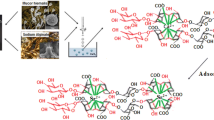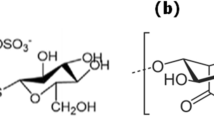Abstract
Residual biomass from a whiskey distillery was examined for its ability to function as a biosorbent for uranium. Biomass recovered and lyophilised exhibited a maximum biosorption capacity of 165–170 mg uranium/g dry weight biomass at 15 °C. With a view towards the development of continuous or semi-continuous flow biosorption processes it was decided to immobilize the material by (1) cross-linking with formaldehyde and (2) introducing that material into alginate matrices. Cross-linking the recovered biomass resulted in the formation of a biosorbent preparation with a maximum biosorption capacity of 185–190 mg/g dry weight biomass at 15 °C. Following immobilization of biomass in alginate matrices it was found that the total amount of uranium bound to the matrix did not change with increasing amounts of biomass immobilized. It was found however, that the proportion of uranium bound to the biomass within the alginate-biomass matrix increased with increasing biomass concentration. Further analysis of these preparations demonstrated that the alginate-biomass matrix had a maximum biosorption capacity of 220 mg uranium/g dry weight of the matrix, even at low concentrations of biomass.
Similar content being viewed by others
Author information
Authors and Affiliations
Additional information
Received: 31 October 1996
Rights and permissions
About this article
Cite this article
Bustard, M., McHale, A. Biosorption of uranium by cross-linked and alginate immobilized residual biomass from distillery spent wash. Bioprocess Engineering 17, 127–130 (1997). https://doi.org/10.1007/s004490050365
Issue Date:
DOI: https://doi.org/10.1007/s004490050365




